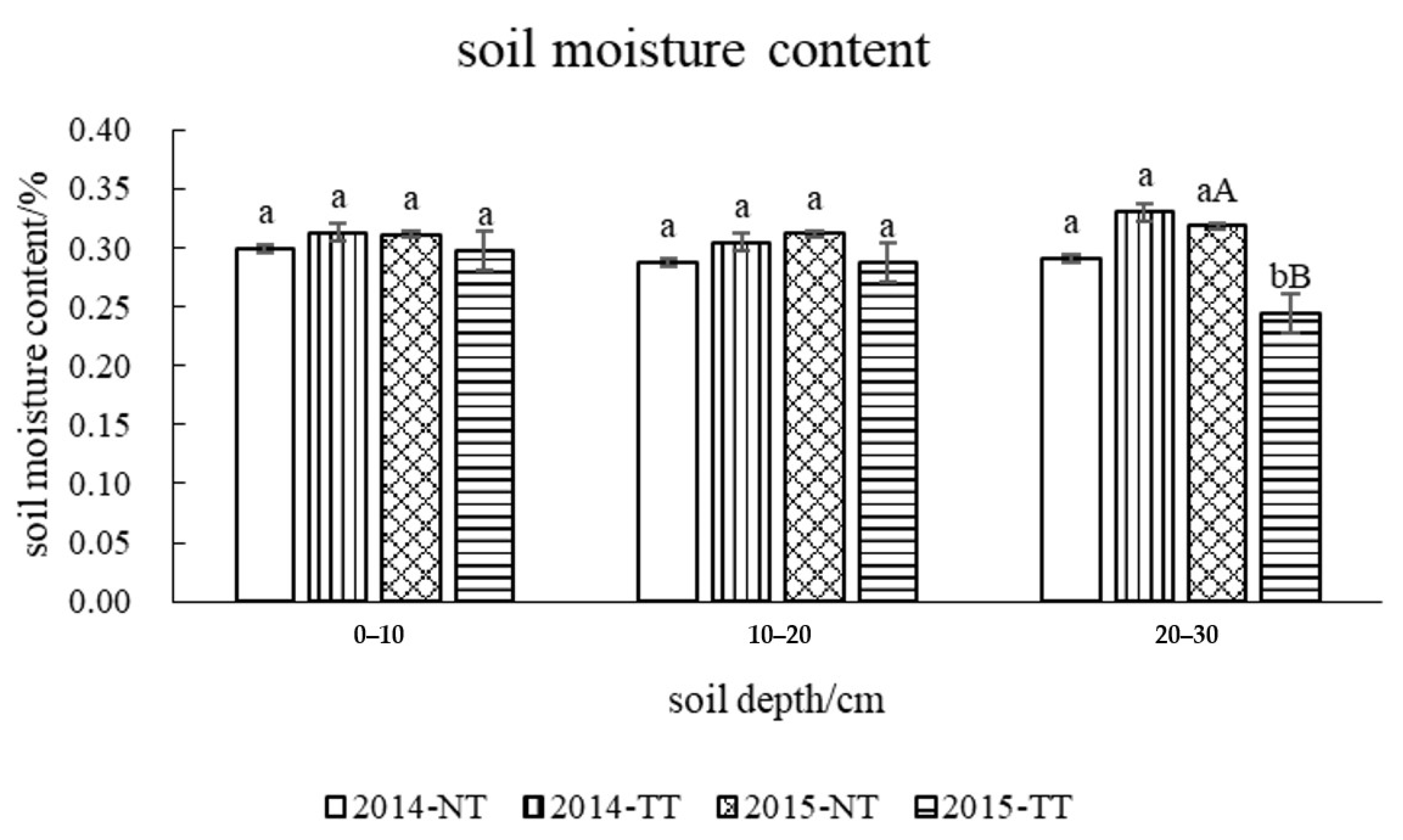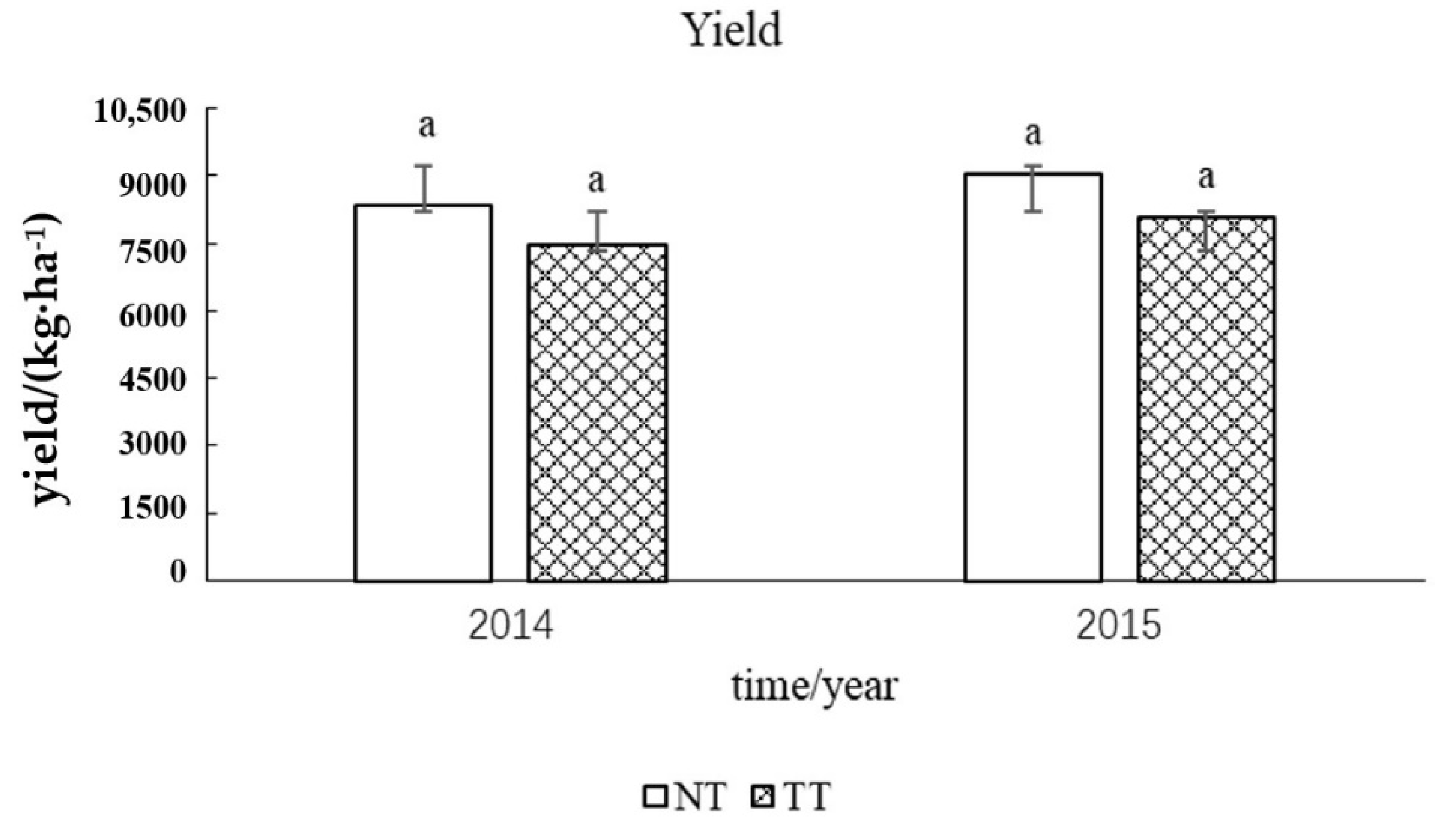Effects of Conservation Tillage on Soil Properties and Maize Yield in Karst Regions, Southwest China
Abstract
:1. Introduction
2. Materials and Methods
2.1. Site Description
2.2. Experimental Design
2.3. Measured Parameters
2.3.1. Bulk Density and Soil Moisture
2.3.2. Soil Sampling and Preparation
2.3.3. SOM, Total N, Available N and Olsen’s P
2.3.4. Yield
2.4. Statistical Analysis
3. Results
3.1. Bulk Density and Soil Moisture
3.1.1. Bulk Density
3.1.2. Soil Moisture
3.2. SOM, Total N, Available N, and Available P
3.3. Yield
4. Discussion
5. Conclusions
Author Contributions
Funding
Institutional Review Board Statement
Informed Consent Statement
Data Availability Statement
Acknowledgments
Conflicts of Interest
References
- Xiao, D.; Ye, Y.; Xiao, S.; Zhang, W.; He, X.; Wang, K. Effects of tillage on CO2 fluxes in a typical karst calcareous soil. Geoderma 2018, 337, 191–201. [Google Scholar] [CrossRef]
- Panno, S.V.; Luman, D.E. Mapping palimpsest karst features on the Illinois sinkhole plain using historical aerial photography. Carbonates Evaporites 2012, 28, 201–214. [Google Scholar] [CrossRef]
- Liu, X.; Zhang, W.; Wu, M.; Ye, Y.; Wang, K.; Li, D. Changes in soil nitrogen stocks following vegetation restoration in a typical karst catchment. Land Degrad. Dev. 2018, 30, 60–72. [Google Scholar] [CrossRef]
- Huang, X.; Zhang, Z.; Zhou, Y.; Wang, X.; Zhang, J.; Zhou, X. Driving Factors and Prediction of Rock Desertification of Non-Tillage Lands in a Karst Basin, Southwest China. Pol. J. Environ. Stud. 2021, 30, 3627–3635. [Google Scholar] [CrossRef]
- Li, R.; Li, Q.; Zhang, J.; Liu, Z.; Pan, L.; Huang, K.; Zhang, L. Effects of Organic Mulch on Soil Moisture and Nutrients in Karst Area of Southwest China. Pol. J. Environ. Stud. 2020, 29, 4161–4174. [Google Scholar] [CrossRef]
- Brouder, S.M.; Gomez-Macpherson, H. The impact of conservation agriculture on smallholder agricultural yields: A scoping review of the evidence. Agric. Ecosyst. Environ. 2014, 187, 11–32. [Google Scholar] [CrossRef]
- Bhattacharya, P.; Maity, P.P.; Mowrer, J.; Maity, A.; Ray, M.; Das, S.; Chakrabarti, B.; Ghosh, T.; Krishnan, P. Assessment of soil health parameters and application of the sustainability index to fields under conservation agriculture for 3, 6, and 9 years in India. Heliyon 2020, 6, e05640. [Google Scholar] [CrossRef]
- Kassam, A.; Li, H.; Niino, Y.; Theodor, F.; He, J.; Wang, X. Current status, prospect and policy and institutional support for Conservation Agriculture in the Asia-Pacific region. Int. J. Agric. Biol. Eng. 2014, 7, 1–13. [Google Scholar] [CrossRef]
- Singh, V.K.; Singh, Y.; Dwivedi, B.S.; Singh, S.K.; Majumdar, K.; Jat, M.L.; Mishra, R.P.; Rani, M. Soil physical properties, yield trends and economics after five years of conservation agriculture based rice-maize system in north-western India. Soil Tillage Res. 2016, 155, 133–148. [Google Scholar] [CrossRef]
- Shahzad, M.; Farooq, M.; Jabran, K.; Yasir, T.A.; Hussain, M. Influence of Various Tillage Practices on Soil Physical Properties and Wheat Performance in Different Wheat-based Cropping Systems. Int. J. Agric. Biol. 2016, 18, 821–829. [Google Scholar] [CrossRef]
- Su, Y.; Gabrielle, B.; Makowski, D. A global dataset for crop production under conventional tillage and no tillage systems. Sci. Data 2021, 8, 1–17. [Google Scholar] [CrossRef] [PubMed]
- Parihar, C.; Yadav, M.; Jat, S.; Singh, A.; Kumar, B.; Pradhan, S.; Chakraborty, D.; Jat, M.; Jat, R.; Saharawat, Y.; et al. Long term effect of conservation agriculture in maize rotations on total organic carbon, physical and biological properties of a sandy loam soil in north-western Indo-Gangetic Plains. Soil Tillage Res. 2016, 161, 116–128. [Google Scholar] [CrossRef]
- Singh, V.K.; Dwivedi, B.S.; Singh, Y.; Singh, S.K.; Mishra, R.P.; Shukla, A.K.; Rathore, S.S.; Shekhawat, K.; Majumdar, K.; Jat, M.L. Effect of tillage and crop establishment, residue management and K fertilization on yield, K use efficiency and apparent K balance under rice-maize system in north-western India. Field Crop. Res. 2018, 224, 1–12. [Google Scholar] [CrossRef]
- Chen, H.; Yang, Y. Effect of fuel saving and crop energy output on controlled traffic system under small machinery in loess plateau of China—Science Direct. Soil Tillage Res. 2020, 199, 104570. [Google Scholar] [CrossRef]
- Latsch, A.; Anken, T. Soil and crop responses to a “light” version of Controlled Traffic Farming in Switzerland. Soil Tillage Res. 2019, 194, 104310. [Google Scholar] [CrossRef]
- Li, H.; He, J.; Bharucha, Z.P.; Lal, R.; Pretty, J. Improving China’s food and environmental security with conservation agriculture. Int. J. Agric. Sustain. 2016, 14, 377–391. [Google Scholar] [CrossRef]
- Kuhn, N.J.; Hu, Y.; Bloemertz, L.; He, J.; Li, H.; Greenwood, P. Conservation tillage and sustainable intensification of agriculture: Regional vs. global benefit analysis. Agric. Ecosyst. Environ. 2016, 216, 155–165. [Google Scholar] [CrossRef]
- Blake, G.R. Bulk density. In Methods of Soil Analysis. Part 1. Physical and Mineralogical Properties. Agronomy Monographs 9; ASA and SSSA: Madison, WI, USA, 1965; pp. 374–390. [Google Scholar]
- Nelson, D.W.; Sommers, L.E. Total carbon, organic carbon and organic matter. In Methods of Soil Analysis, Monograph No. 9; Page, A.L., Miller, R.H., Keeney, D.R., Eds.; ASA and SSSA: Madison, WI, USA, 1982; pp. 539–579. [Google Scholar]
- Dorich, R.A.; Nelson, D.W. Evaluation of Manual Cadmium Reduction Methods for Determination of Nitrate in Potassium Chloride Extracts of Soils. Soil Sci. Soc. Am. J. 1984, 48, 72–75. [Google Scholar] [CrossRef]
- Hedley, M.J.; Stewart, J.W.B. Method to measure microbial phosphate in soils. Soil Biol. Biochem. 1982, 14, 377–385. [Google Scholar] [CrossRef]
- Li, Y.; Zeng, H.L.; Wang, G.F.; Wang, Z.Y.; Chen, X.Y.; Zou, X.K.; Shi, S.; Jiang, Y.D.; Zhao, L.; Zhou, B.; et al. Climatic char-acteristics and major meteorological events over China in 2019. Meteor. Mon. 2020, 46, 547–555. [Google Scholar]
- Xu, J.; Han, H.; Ning, T.; Li, Z.; Lal, R. Long-term effects of tillage and straw management on soil organic carbon, crop yield, and yield stability in a wheat-maize system—Science Direct. Field Crops Res. 2019, 233, 33–40. [Google Scholar] [CrossRef]
- Ding, J.; Hu, W.; Wu, J.; Yang, Y.; Feng, H. Simulating the effects of conventional versus conservation tillage on soil water, nitrogen dynamics, and yield of winter wheat with RZWQM2. Agric. Water Manag. 2019, 230, 105956. [Google Scholar] [CrossRef]
- Zhang, Z.; Qiang, H.; McHugh, A.D.; He, J.; Li, H.; Wang, Q.; Lu, Z. Effect of conservation farming practices on soil organic matter and stratification in a mono-cropping system of Northern China. Soil Tillage Res. 2016, 156, 173–181. [Google Scholar] [CrossRef]
- Peigné, J.; Vian, J.-F.; Payet, V.; Saby, N.P. Soil fertility after 10 years of conservation tillage in organic farming. Soil Tillage Res. 2018, 175, 194–204. [Google Scholar] [CrossRef]
- Singh, A.; Phogat, V.; Dahiya, R.; Batra, S. Impact of long-term zero till wheat on soil physical properties and wheat productivity under rice–wheat cropping system. Soil Tillage Res. 2014, 140, 98–105. [Google Scholar] [CrossRef]
- Wang, H.; Wang, S.; Yu, Q.; Zhang, Y.; Wang, R.; Li, J.; Wang, X. No tillage increases soil organic carbon storage and decreases carbon dioxide emission in the crop residue-returned farming system. J. Environ. Manag. 2020, 261, 110261. [Google Scholar] [CrossRef]
- Chaudhary, V.P.; Parmanik, M.; Patel, A. Effect of conservation tillage and crop residue management on soil physical prop-erties and crop productivity of wheat. Ama Agric. Mech. Asia Afr. Lat. Am. 2017, 48, 62–70. [Google Scholar]
- Mirzavand, J.; Moradi-Talebbeigi, R. Relationships between field management, soil compaction, and crop productivity. Arch. Agron. Soil Sci. 2020, 67, 675–686. [Google Scholar] [CrossRef]
- Sharma, S.; Thind, H.S.; Singh, Y.; Sidhu, H.S.; Jat, M.L.; Parihar, C.M. Effects of crop residue retention on soil carbon pools after 6 years of rice–wheat cropping system. Environ. Earth Sci. 2019, 78, 296. [Google Scholar] [CrossRef]
- Li, H.; Wang, Q.J.; He, J.; Li, H.W.; Lu, Z.Y.; Rasaily, R.G.; Lu, C.Y.; Zhang, X.C.; Zheng, Z.Q. Permanent Raised Beds Improved Soil Physical Properties in an Annual Double-Cropping System. Agron. J. 2014, 106, 7–14. [Google Scholar] [CrossRef]
- Irmak, S.; Kukal, M.; Mohammed, A.; Djaman, K. Disk-till vs. no-till maize evapotranspiration, microclimate, grain yield, production functions and water productivity. Agric. Water Manag. 2019, 216, 177–195. [Google Scholar] [CrossRef]
- Hu, H.; Lu, C.; Wang, Q.; Li, H.; He, J.; Xu, D.; Wang, X. Influences of wide-narrow seeding on soil properties and winter wheat yields under con-ser-vation tillage in North China Plain. Int. J. Agric. Biol. Eng. 2018, 11, 54–60. [Google Scholar] [CrossRef]




| Soil Depth (cm) | Bulk Density (g·cm−3) | SOM (g·kg−1) | Total N (g·kg−1) | Available N (mg·kg−1) | Available P (mg·kg−1) |
|---|---|---|---|---|---|
| 0–10 | 1.19 | 25.32 | 1.16 | 85.99 | 8.88 |
| 10–20 | 1.27 | 23.28 | 0.94 | 75.71 | 7.84 |
| 20–30 | 1.36 | 20.06 | 0.88 | 63.15 | 5.72 |
| Year | Depth/cm | SOM (g·kg−1) | Total N (g·kg−1) | Available N (mg·kg−1) | Available P (mg·kg−1) | ||||
|---|---|---|---|---|---|---|---|---|---|
| NT | TT | NT | TT | NT | TT | NT | TT | ||
| 2014 | |||||||||
| 0–10 | 27.13(a) | 25.48(a) | 1.21(a) | 1.19(a) | 89.7(a) | 83.76(a) | 9.22(aA) | 8.77(bB) | |
| 10–20 | 24.85(a) | 23.87(a) | 1.04(a) | 0.93(b) | 77.36(a) | 73.53(a) | 8.08(a) | 7.83(b) | |
| 20–30 | 20.87(a) | 19.83(a) | 0.95(a) | 0.89(a) | 65.86(a) | 65.81(a) | 6.27(aA) | 5.95(bB) | |
| 2015 | |||||||||
| 0–10 | 28.55(aA) | 24.28(bB) | 1.27(a) | 1.14(b) | 91.97(aA) | 84.65(bB) | 10.56(aA) | 8.95(bB) | |
| 10–20 | 25.73(a) | 23.15(b) | 1.06(a) | 0.93(b) | 79.77(a) | 73.40(b) | 8.91(aA) | 8.06(bB) | |
| 20–30 | 21.41(a) | 19.79(a) | 0.96(a) | 0.84(b) | 67.35(a) | 61.25(a) | 6.32(a) | 5.84(b) | |
Publisher’s Note: MDPI stays neutral with regard to jurisdictional claims in published maps and institutional affiliations. |
© 2022 by the authors. Licensee MDPI, Basel, Switzerland. This article is an open access article distributed under the terms and conditions of the Creative Commons Attribution (CC BY) license (https://creativecommons.org/licenses/by/4.0/).
Share and Cite
Bai, L.; Kong, X.; Li, H.; Zhu, H.; Wang, C.; Ma, S. Effects of Conservation Tillage on Soil Properties and Maize Yield in Karst Regions, Southwest China. Agriculture 2022, 12, 1449. https://doi.org/10.3390/agriculture12091449
Bai L, Kong X, Li H, Zhu H, Wang C, Ma S. Effects of Conservation Tillage on Soil Properties and Maize Yield in Karst Regions, Southwest China. Agriculture. 2022; 12(9):1449. https://doi.org/10.3390/agriculture12091449
Chicago/Turabian StyleBai, Lizhen, Xiangying Kong, Hui Li, Huibin Zhu, Chengwu Wang, and Shiao Ma. 2022. "Effects of Conservation Tillage on Soil Properties and Maize Yield in Karst Regions, Southwest China" Agriculture 12, no. 9: 1449. https://doi.org/10.3390/agriculture12091449
APA StyleBai, L., Kong, X., Li, H., Zhu, H., Wang, C., & Ma, S. (2022). Effects of Conservation Tillage on Soil Properties and Maize Yield in Karst Regions, Southwest China. Agriculture, 12(9), 1449. https://doi.org/10.3390/agriculture12091449






